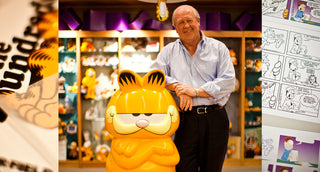In late 2010, The Hundreds and Garfield partnered for the first time in a milestone collaboration. We had a pop-up shop with a group art show featuring Garfield interpretations by Barry McGee, Slick, and Lance Mountain. The 1980s-themed collection immediately sold out.
8 years later, The Hundreds X Garfield returns this Thursday in celebration of The Hundreds’ 15-year Anniversary. Here's Bobby Hundreds' 2010 The Hundreds Magazine interview with cartoonist Jim Davis.
I can’t search far within my childhood memories without running into tabby orange fur and black stripes. Jim Davis’ Garfield—a comic strip about a sarcastic orange cat, his owner Jon Arbuckle, and Odie the dog—was ubiquitous in the ‘80s and ‘90s. Not just in the Sunday comics and Saturday morning television, but on my bookshelf and everywhere else in my bedroom. To this day, I still can’t eat lasagna without feeling a little bit Garfield.

Garfield taught me how to draw cartoons and I swore that one day I’d make a living off of my art the way Jim Davis did. It’s painfully obvious that much of my sense of humor came from the fat cat as well. So I got on a plane and flew across the country to Muncie, Indiana, to visit Garfield’s headquarters, Paws Inc., located in a massive wooden complex, oddly reminiscent of an Indiana farmhouse. This is the house that Garfield built, all at the hand of his creator, Jim Davis. The cartoonist still lives not 100 yards away with his wife Jill. His brother across the road, his daughter next door.
In 1978, Davis started drawing a small, unknown comic strip about single guy Jon Arbuckle and his sarcastic pet cat. 40 years later, he’s still doing the same, although Garfield has now manifested into a household name that’s as recognizable as, let’s say, Mickey Mouse (No, really, Garfield’s familiarity is 94% amongst Americans. Mickey’s about 95%. Chevrolet, by comparison, is 76%). I think it’s fair to say that Garfield is a big fat hairy deal.

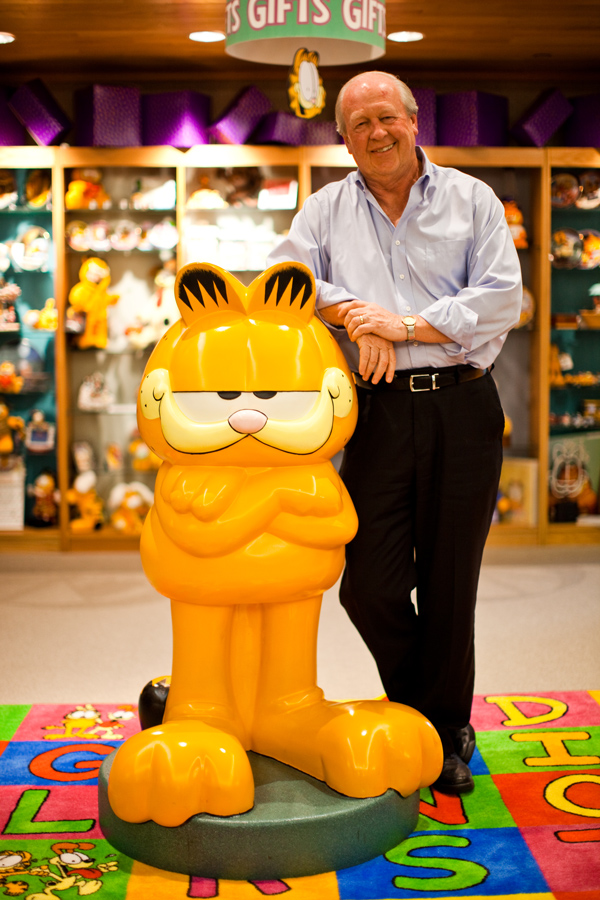
BOBBY HUNDREDS: How important is the comic format for Garfield? Is that still integral to its life?
JIM DAVIS: You’re talking about the 3-panel strip? Yeah. It is for my timing and style. To me, working on the animation stuff is much easier than the comic strip because you can let Garfield run, he can try to stop, there’s music, sound effects, all kinds of things. But with the comic strip, there’s no audio, no animation, plus you have to freeze-frame the character in the perfect position with the perfect expression to get the idea across. You have about 25 words or less. You only have about 7 inches within which to work. You have to set up the plot, twist it, and resolve it in that space, so it’s very tough. I love the challenge of using the economy of not only words, but of line, to get the point across. If you ever read a comic strip to someone, you realize it’s not as funny when you say it out loud as it is when you say it to yourself, in your head. So I write it for performing in your head, plus I try to get to the punchline an instant before the reader does. That’s the trick. That invokes the involuntary laugh response. If they see the gag coming, you’re dead on arrival. If it takes too long for them to get the gag after you’ve hit them with it, now they’re struggling with it or give up on it. So, it’s great fun.
“I try to get to the punchline an instant before the reader does. That’s the trick.”
In newspapers, there was only so much real estate. Obviously with the internet, we could do animation, all sorts of stuff if we wanted. Fortunately, the 3-frame, 4-frame comic is still alive and well, because the young cartoonists have (like you growing up drawing Garfield) started with that style. I think we have this honeymoon, at least for the rest of my career, of being able to work in that style. Who knows what the comic strip’s going to be. If you add sound effects and you actually act it out, you’ve lost that kind of timing (Not that comics won’t be animated in the future).
What I like about it as well, even with everything being digitized, you still have to be able to draw. It still takes an artist to draw the line. That’s going away as well. We actually have software for kids, on our website, which allows them to create comic strips by simply picking shapes, eyes, ears, you know, all the stuff for the avatars. They can create their own without having to draw it out, at least the way we’re doing it. It’s still preserving the art because cartooning, and the comic strip, is a uniquely American art form. We created it, with The Yellow Kid, and then the Katzenjammer Kids, so that’s something that needs to be preserved.

On the topic of running the joke in your head, I was probably reading Garfield for three years as a kid before I realized that the cat was just emanating thought bubbles. Once I figured that out, it totally changed my perspective. That’s something that’s just uniquely Garfield.
That’s true. Snoopy actually never talked. I didn’t do it because he didn’t talk but I always felt like you watch pet owners and they talk to their animals like they understand. I always thought that was funny because people attribute human thoughts and feelings to cats anyway. You can’t really read them. Dogs, you can read. You know what’s on a dog’s mind. If he wants to bite you, it’s painfully obvious. Or if he’s done something wrong, you know, they’re terrible liars. But cats, they’re pretty special when it comes to that, so I figured I could get away with it. Garfield is a human in a cat suit.
Why did you focus more on Garfield instead of investing in the other characters?
Actually, I don’t really talk about it very much, but I originally created the strip to be about Jon. I was going to call it Jon, about a single guy who’s kind of shy, not socially adept, so I gave him this cat. Obviously humor comes from contrast, humor comes from conflict. If everyone’s agreeing and they’re all happy, there’d be no more jokes. So I did, I created contrast to Jon, in the cat. But every time we got to the punch line, the cat had the funny line, just zinging Jon. So as many other characters as I tried to add, Garfield literally took the strip over.
“Garfield is a human in a cat suit.”
I worked for T.K. Ryan at that time on the Tumbleweeds comic strip. I was his assistant. I did his backgrounds, borders, and things like that. When I showed it to Tom, I said, “Every time I write this strip, the cat’s got the punch line.” And Tom said, “He’s telling you something. Go with it.” So I did. I changed the name of the strip from Jon to Garfield. I ran it in a local weekly paper to see what it looked like (I don’t think they paid me). And he was right, the cat had the funny lines, so I started focusing on the cat. More often than not, when we laugh at a gag, it’s because we’re saying, “Isn’t that true?” I just hold a mirror to the reader, is all I do, so that’s what Garfield does, particularly these days, when we’re made to feel guilty about overeating and oversleeping. Garfield says, “Hey, that’s the way we’re made.” He’s cool with that. He’s not perfect, but that’s ok. He’s really comfortable in his own skin, which I think sends a good message. He doesn’t have the best habits, but none of us do. But he has the courage to openly be that way.
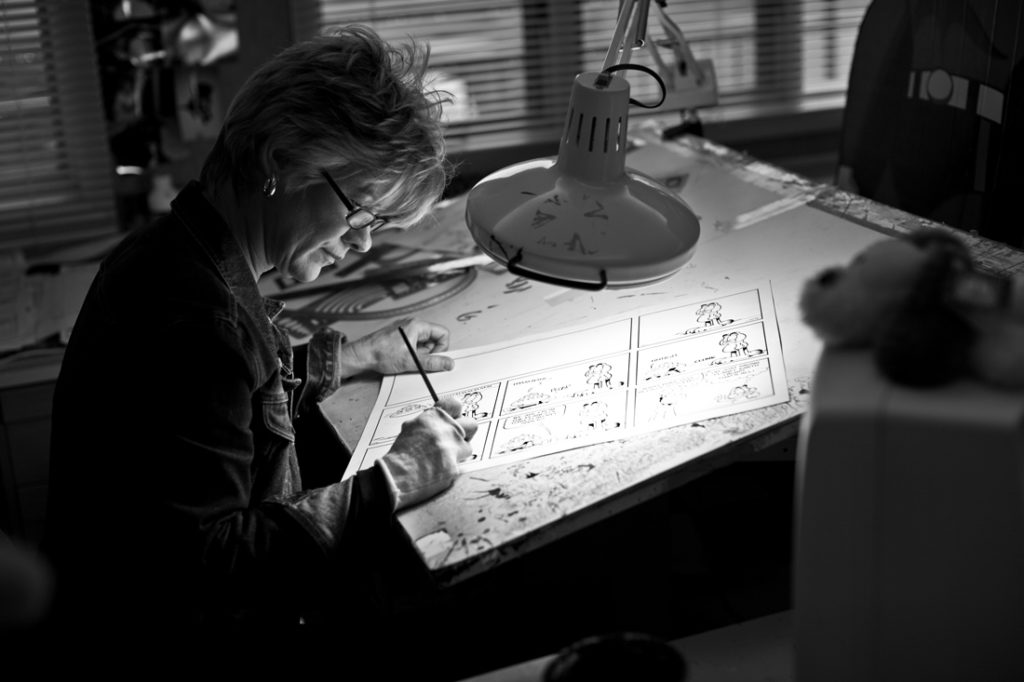
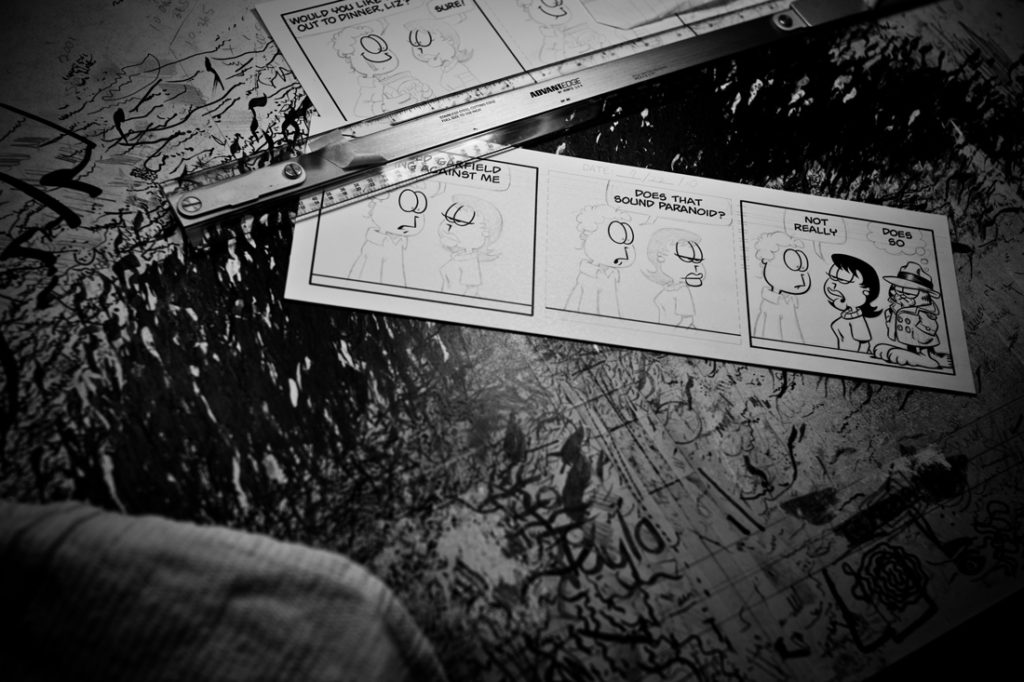
My wife tends to believe I grew up a Garfield fan because of his dark humor. Have you ever considered the comic to have darker undertones?
He takes great delight, yeah, in a lot of other people’s pain. He’s a bit of a sociopath in that respect. Interesting thought, I never really thought about that, because I personally laugh about everything, but that’s not what I put in the strip. It’s the edgier, the funnier me, but the trick is to make everyone laugh. One day I want to write the gag that makes the whole world laugh, I think that’d be cool.
I don’t get too dark with it. Plus, I think, that’s the easier laugh. It’s really easy to make people laugh at bodily humor or a shocked kind of a laugh, or an embarrassed kind of laugh. A lot of people are doing it. South Park, obviously, is a great example. I try to do it through situational humor. Have them overeat. Now what’s funny about that? Send him up a tree! What, in that situation, is really funny? So he reacts to things. But you’re right, he just randomly kicked Odie off the table and he said, “I’m not known for my compassion.” So I guess he’s not compassionate, which opens him up to a little... yeah, he’s certainly got a dark side.

There’s something to be said about the cross-generational appeal of Garfield...
In the 21st Century Comics Poll, this really big poll that was taken by the National Cartoonists Society, and it was newspaper editors finding out what people liked about the comics. One of the things they liked, the fact that there was something they could count on. They expected to see Snoopy on his doghouse and they expect to see Garfield go for the lasagna. In these days when there’s so much uncertainty, it’s nice to go to a place where you can go back. And I think that’s why it was such a shock when Sparky [Charles Schulz, creator of Peanuts] passed away. He’d been doing it for fifty years, he was supposed to do it for another fifty years. For me, it was terrible, it was just crushing. Fifty years! That’s not like a sitcom that goes two seasons, or has a great run of 8 years, it’s like fifty years, that’s your life. You grow up, you learn to read, you get married, you raise kids, reading the same comic, you know, with Snoopy laying on the doghouse.
“One day I want to write the gag that makes the whole world laugh, I think that’d be cool.”
It’s interesting, though, because of your interest with The Hundreds. There was a teen study and the biggest appeal to teens for Garfield—he makes them laugh, one, and two, he’s hip. It totally caught me off guard. There’s nothing hip in his dialogue, because nothing will date you any quicker than if you use “tubular.” So I avoid that, because people will be eating and sleeping a few generations from now. I guess it’s his attitude, so it’s not the way he says it, but what he feels. He resents authority and that’s always going to be in. He doesn’t obey Jon, who is the parental figure. He’s hip in that respect, so that’s cool.
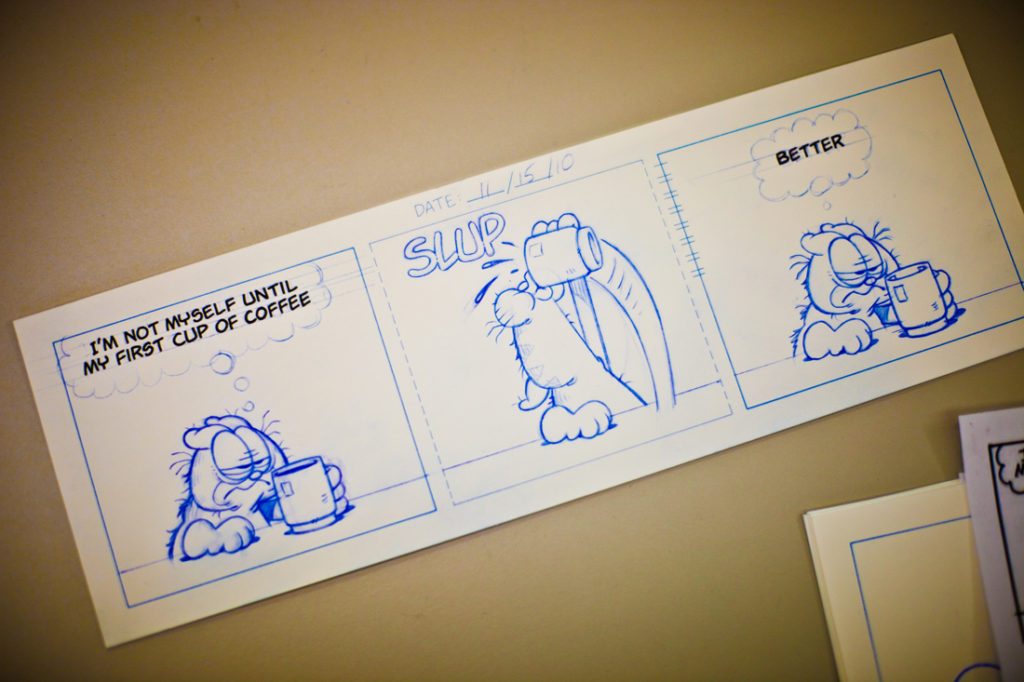
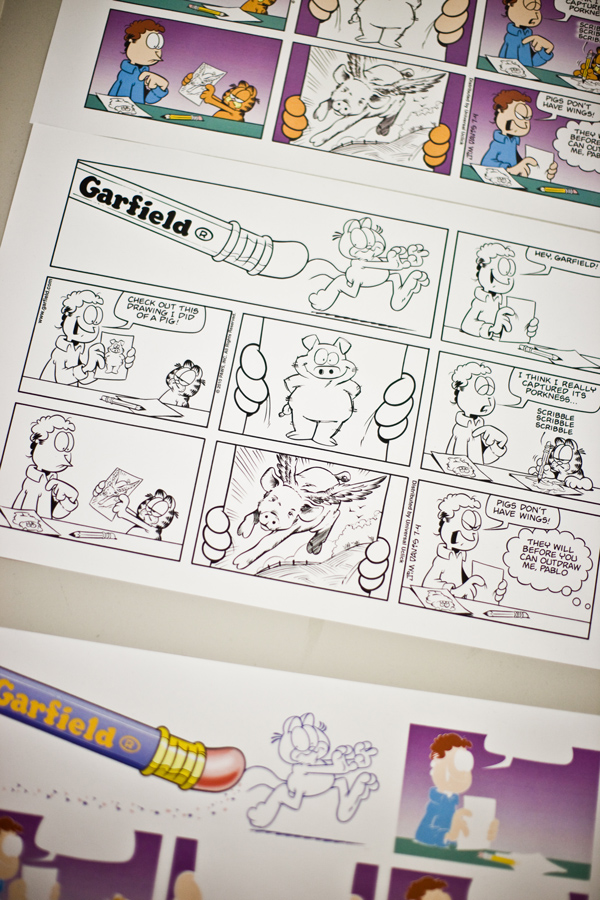
On somewhat of a tangent, I was as much a U.S. Acres fan as Garfield in the ‘80s. But it always seemed like the redheaded stepchild, and it disappeared as quickly as it came about. Can you tell us the story?
I’ve never actually told this story. It was Sunday morning, I was reading the Sunday paper, and my son James goes, “Dad, what’s a transvestite?” “Pardon me?” It was in the comics. I forget what the strip was. At that point, it occurred to me that the comics were done for adults, by adults, by and large. I’ve always tried to do the Sunday for kids as well, by letting the pictures tell a story, and let the dialogue go where the dialogue goes. A lot of times, kids and adults will both laugh at our Sunday strips, but for two different reasons. Sometimes if you just look at Garfield’s pictures, he’ll tell a story or do something funny to make a preschooler laugh. I like to keep something a little kinetic in the Sunday, just for kids. That was 25 years ago. Even then, kids were moving away from newspapers because of Atari. The Apple IIe was out. I saw early on, newspapers were going to be in trouble.
I did it just to do something for very young readers and to do something big. I grew up on a farm, big and bright, and at that time, we had a very successful run with our primetime specials; [points] you can see the Emmys over there [for the writing on four of the specials]. CBS wanted us to do Saturday morning. I said, “Half an hour is a lot of time with just one cat.” I think every Saturday, we’d wear them out, plus it’s a lot of material. However, if you put U.S. Acres in there, we could hop back and forth at least, and break up the monotony. Because Garfield has his unique pacing. He’s a little slow compared to the Warner Brothers characters, especially. And they said OK. So we put together a great cast of voice talent. We had more fun with the U.S. Acres characters and we did that for seven years for CBS. But I did it for the young readers. In fact, the strip only ran, I think, for three years. It started with a lot of papers, but I was sitting across from the editor of the Boston Globe, and he said he didn’t think he was going to be keeping U.S. Acres. I said, “Why not? It’s for young readers.” He says, “Kids don’t buy our advertising.” And that was the mentality. We were winning comics polls with young readers.

Unfortunately, that’s still the mentality with newspapers.
They’re really struggling with that, because now they’ve lost a generation of kids who just moved away from the papers. At any rate, circulation was down, Garfield was taking as much, or more time, and we just made a really tough decision. We were still in several hundred papers, but I opted to end the series just because of all this stuff going on. I didn’t want to do a second-rate job on Garfield, so I just had to end it, but I loved doing it. The shows still run today in syndication. People still know the characters. We had more fun with Wade the Duck, panaphobe, afraid of everything...
Actually, they’re going to do a little cameo appearance in our TV series coming up. We’re gonna go find Thom Huge out in Wyoming and bring him back to do Roy, so it’s gonna be fun to get that crew back together. Actually Orson is Odie, so some of the voices are still doing the Garfield voices anyway because it’s a repertoire group. He’s been doing Odie since day one, since 1980. So that’s neat. We’ve got a lot of the old crew still together. Mark Evanier, he did the CBS series years ago.
So the U.S. Acres was just for the kids. Did it for my son. Today he starts Ball State University, in the art department. He’s in his first class right now. I’m really proud of him.
Garfield’s Halloween Adventure aired in 1985 and won an Emmy in 1986 for Outstanding Animated Program (the third Garfield special to win the Emmy).
I want to talk about brand integrity, ‘cause I also read Bill Watterson’s comic (Calvin and Hobbes) and the approach Watterson took to licensing and merchandising was obviously a completely different philosophy. He didn’t authorize Calvin to be on one product. Were you ever concerned that the amount of Garfield licensing would harm the integrity of the comic and brand? Obviously, it’s something that we ourselves deal with everyday just within our own brand.
Oh absolutely. Doing plush allowed us to do them in 3D, so I got to turn them over and feel them and things like that. Doing the books was the perfect venue for continuing the comic strip behavior. Obviously the TV shows are great. The posters and cards, that’s taking his attitude and doing really fun stuff with it. Doing office stuff just drives his personality further. He has the courage to say things people wish they could so they want stuff with him saying it so they don’t have to. That kind of stuff helps drive the personality of the character.
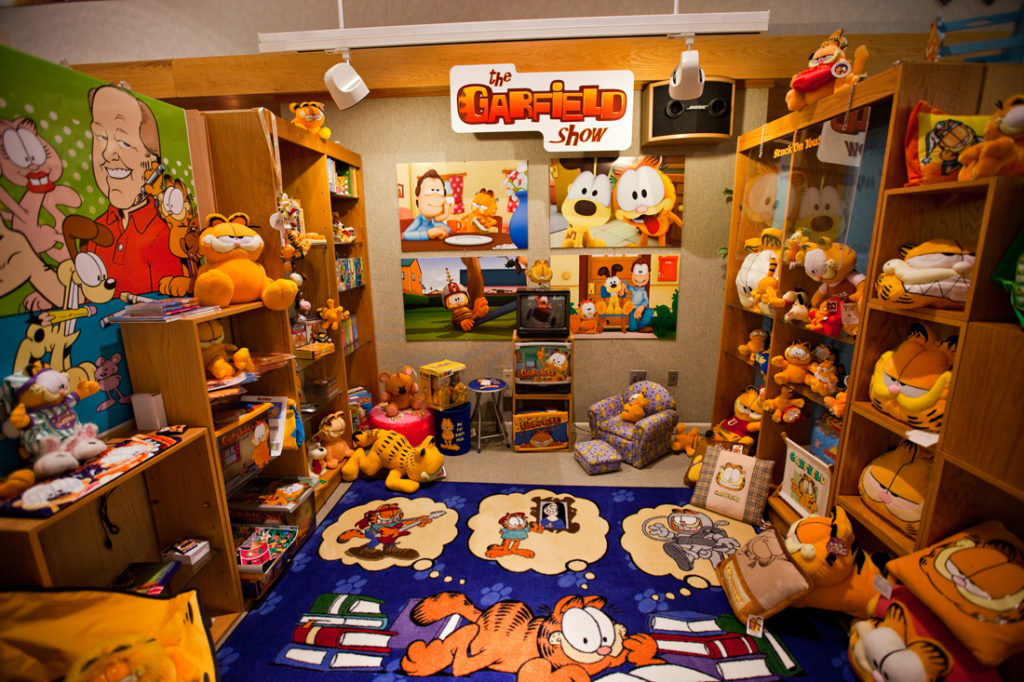
I thought if we could design Garfield to the product for the product’s market, we would have something that would be good quality and be very appropriate. And also, would allow me to get to do things for the property that maybe I wouldn’t if I just did the comic strips. Because I thought, “If I do this, maybe I’ll get to do that, if I get to do that…” And as a result I had the opportunity to do lots of things. And certainly get to grow a staff.
“If we take care of the cat, the cat will take care of us.”
That, for me, is a lot more fun and a lot more challenging: growing and logistics. There’s a thing called the Aristotelian Mean, meaning just to stay where you are, you have to keep moving ahead. Because everything else is marching ahead. So just to stay where you are, you gotta keep growing. So Bobby, you’re an empire builder [laughs]! You can understand that everything’s relative. If I were to just rely on the comic strip and just do that, oh I’d probably be retired by now. I’d be a poor handicapped golfer by now, but wouldn’t have had nearly as much fun getting to this place. So, honestly, it wasn’t so much the money as it was the challenge, the opportunity to do things. Just that part of me saying, “Hey if you wanna do it, you have to do it right.” If we take care of the cat, the cat will take care of us. So we don’t worry so much about production budgets or end of the month statements as we do about something that’s really good for the cat. Because if it’s good for the cat, then it’s good for us.
***
Photos by Bobby Hundreds.
The Hundreds X Garfield is sold out in our Online Shop, so here's a list of global stockists that may still carry the collab in-store and online.
![]()

